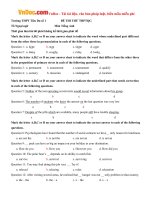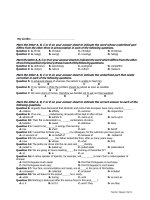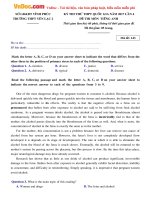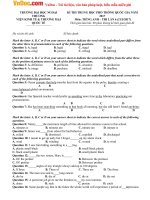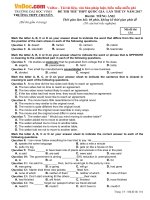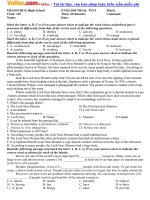Đề thi thử THPT Quốc gia năm 2017 môn Tiếng Anh trường THPT Cảm Nhân, Yên Bái CÓ ĐÁP ÁN (1)
Bạn đang xem bản rút gọn của tài liệu. Xem và tải ngay bản đầy đủ của tài liệu tại đây (624.43 KB, 6 trang )
VnDoc - Tải tài liệu, văn bản pháp luật, biểu mẫu miễn phí
SỞ GD&ĐT YÊN BÁI
TRƯỜNG THPT CẢM NHÂN
ĐỀ CHÍNH THỨC
Đề thi gồm có 05 trang
KỲ THI THPT QUỐC GIA NĂM 2017
Môn TIẾNG ANH
Thời gian làm bài: 60 phút, không kể thời gian phát đề
----------------------------------------------------------------
Mark the letter A, B, C, or D on your answer sheet to indicate the word whose underlined part
differs from theother threein pronunciationineach of thefollowing questions.
Question 1: A. high
B. hour
C. house
D. home
Question 2: A. nation
B. patience
C. cancer
D. basic
Mark the letter A, B, C, or D on your answer sheet to indicate the word that differs from the other
three in the position of primary stress in each of the following questions.
Question 3: A. algebra
Question 4: A. chamistry
B. carefully
B. computing
C. academic
C. september
D. politics
D. academic
Mark the letter A, B, C, or D on your answer sheet to indicate the underlined part that needs
correctionineachofthefollowingquestions.
Question 5: I would like to working as a doctor. Working as a doctor would be a
A
B
C
D
fascinating job.
Question 6: Don’t forget to saying goodbye to the interviewer before leaving the
A
B
C
D
office.
Question 7: The house will be repaint by them soon.
A
B
C
D
Mark the letter A, B, C, or D on your answer sheet to indicate the correct answer to each of the
following questions.
Question 8: I did not use______ under so much pressure but now I have got used to it.
A. to work
B. to be worked
C. working
D. to working
Question 9: If you work hard, you will eventually ________.
A. successfully
B. successful
C. succeed
D. success
Question 10: These days everybody is aware ________ the danger of smoking.
A. of
B. at
C. for
D. to
Question 11: It is wrongly believed that natural resources will never be_____.
A. used up
B. used out
C. used away
D. used off
Question 12: I took the damaged watch to my watch maker______ knows how to repair all sorts of
things.
A. which
B. where
C. whose
D. who
Question 13: She has worked as a secretary _____ she graduated from college.
A. since
B. before
C. until
D. while
Question 14: Jim is five centimeters _____ than Tom.
A. tall
B. tallest
C. higher
D. taller
Question 15: She speaks Chinese as ________ as I do.
A. well
B. good
C. very good
D. better
Question 16: The coat is ______ for me to wear.
A. very much
B. too large
C. so much
D. too much
Question 17: For the past two years I ________ a lot of things.
A. doing
B. do
C. have done
D. did
Question 18: Fast food restaurants have become popular because many working people want ______.
Trang 1/6
VnDoc - Tải tài liệu, văn bản pháp luật, biểu mẫu miễn phí
A. eat quickly and cheaply
B. to eating quickly and cheaply
C. eating quickly and cheaply
D. to eat quickly and cheaply
Question 19: He will take us to the town ______ we can see old temples.
A. whom
B. where
C. when
D. which
Mark the letter A, B, C, or D on your answer sheet to indicate the most suitable response to
complete each of the following exchanges.
Question 20: Linda: "Excuse me! Where’s the post office?"
Maria: "______."
A. It’s over there B. Don’t worry
C. I'm afraid not
D. Yes, I think so
Question 21: : Tom: “How did you get here?”
John: “______”
A. Is it far from here?
B. I came here last night.
C. The train is so crowded.
D. I came here by train.
Mark the letter A, B, C, or D on your answer sheet to indicate the word(s) CLOSEST in meaning to
theunderlinedword(s)ineachofthefollowingquestions.
Question 22: : When their rent increased from 200 to 400 a month, they protested against such
a tremendous increase.
A. light
B. huge
C. tiring
D. difficult
Question 23: In 1952, Akihito was officially proclaimed heir to the Japanese throne.
A. installed
B. declared
C. denounced
D. advised
Mark the letter A, B, C, or D on your answer sheet to indicate the word(s) OPPOSITE in meaning to the
underlinedword(s)ineachofthefollowingquestions.
Question 24: There is growing concern about the way man has destroyed the environment.
A. ease
B. attraction
C. consideration
D. speculation
Question 25: Fruit and vegetables grew in abundance on the island. The islanders even exported the
surplus.
A. large quantity
B. small quantity C. excess
D. sufficiency
Mark the letter A, B, C, or D on your answer sheet to indicate the sentence that is closest in
meaning toeachofthefollowingquestions.
Question 26: “I’m very sorry for what happened but you will just have to accept the truth.” Laura
said to her friend.
A. Laura took the responsibility for what had happened.
B. Laura didn’t mean to tell the truth.
C. Laura apologized to her friend for what had happened.
D. Laura consoled her friend.
Question 27: No matter how hard he tried, Mike could not make sense of his economics textbook.
A. Mike could not understand his economics textbook because he hardly tried to at all.
B. In spite of his efforts, Mike was unable to understand the contents of his economics textbook.
C. If Mike had studied harder, he would have been able to comprehend what was in his economics
textbook.
D. It was impossible for Mike to understand his economics textbook without making a great effort.
Question 28: I have seen all of her films but one.
A. I have seen only one film of hers.
B. I have seen one of her films.
C. There is only one film of hers that I have not seen.
D. I have finished seeing even one film of hers.
Mark the letter A, B, C, or D on your answer sheet to indicate the correct sentence that is made by
the following words given.
Trang 2/6
VnDoc - Tải tài liệu, văn bản pháp luật, biểu mẫu miễn phí
Question 29: plants/animals/survive/ oxygen.
A. Neither plants nor animals can survive having oxygen.
B. Neither plants or animals can survive without oxygen.
C. Neither plants nor animals can survive without oxygen.
D. Not plants nor animals can survive with no oxygen.
Question 30: Never/history/humanity/there/be/more people/live/world.
A. Never in the history of humanity there are more people living in this world.
B. Never in the history of humanity has there been more people to live in this world.
C. Never in the history of humanity are there more people living in this world.
D. Never in the history of humanity have there been more people living in this world
Read the following passage and mark the letter A, B, C, or D on your answer sheet to indicate
the correct word or phrase that best fits each of the numbered blanks from 31 to 35.
Today, supermarkets are found in almost every large city in the world. But the first
supermarket (31)______opened only fifty years ago. It was opened in New York by a man named
Michael Cullen. A supermarket is different (32) ______other types of stores in several ways. In
supermarkets, goods are placed on open shelves. The (33) ______choose what they want and take
them to the checkout counter. This means that fewer shop assistants are needed than in other stores.
The way products are displayed is another difference between supermarkets and many other types of
stores; (34) ______ example, in supermarkets, there is usually a display of small inexpensive items
just in front of the checkout counter: candies, chocolates, magazines, cheap foods and so on. Most
customers (35) ______ go to a supermarket buy goods from a shopping list. They know exactly what
they need to buy. They do the shopping according to a plan.
A. was
B. were
C. has been
D. is
Question 31:
Question 32:
A. from
B. with
C. in
D. of
Question 33:
A. managers
B. assistants
C. customers
D. sellers
Question 34:
A. in
B. of
C. for
D. by
Question 35:
A. who
B. what
C. whom
D. which
Read the following passage and mark the letter A, B, C, or D on your answer sheet to indicate
the correct answer to each of the questions from 36 to 42.
Psychologists who study information processing have identified and described several
memory structures that clarify how our memory works. They include the sensory register short-term
memory, and long-term memory. Each structure varies as to how much information it can hold and
for how long.
A description of how human process information typically begins with environmental stimuli.
Our sense receptors are constantly stimulated by visual, auditory, tactile, olfactory, and gustatory
stimuli. These experiences are initially recorded in the sensory register, so named because
information is thought to be encoded there in the same form in which it was perceived. The purpose
of the sensory register is to hold information one to three seconds. Information not recognized or
otherwise selected by us disappears from the system. The sensory
register can hold about twelve items of information at a time. Typists make extensive use of
the sensory register in order to remember words just long enough to get them typed. If no further
processing takes place, a typist’s ability to recall that information later is minimal. Similarly, most of
us have had the experience of reading an entire page of text, only to discover when we got to the
bottom of the page, we couldn’t say anything about it except that we had indeed “read” every word.
Once information has been recognized as meaningful, it is sent to short-term memory. In this
case, short-term is approximately 20 seconds. While this may seem surprising, it can be easily
demonstrated. If you were asked to dial an unfamiliar phone number, received a busy signal, and
Trang 3/6
VnDoc - Tải tài liệu, văn bản pháp luật, biểu mẫu miễn phí
were then distracted by something or someone else for 15 to 20 seconds, chances are you would have
forgotten the number at that point. Short-term memory is often referred to as “working” memory.
Most cognitive psychologists believe that the storage capacity of long-term memory is
unlimited and contains a permanent record of everything an individual has
learned and experienced. Information is encoded there to enhance its meaningfulness and
organization so that it can be easily retrieved when necessary.
Question 36: What is the purpose of the passage?
A. To explain how our memory processes information.
B. To describe the sensory register.
C. To explain why we sometimes forget information.
D. To compare short-term and long-term memory.
Question 37: The word “They” in paragraph 1 refers to__________.
A. psychologists
B. information
C. memory structures
D. environmental stimuli
Question 38: The word “stimuli” in lines 5 and 7 is closest in meaning to __________.
A. objects or events that activate our memory.
C. things that help us to later recall what happened.
B. objects we consider attractive.
D. situations in which we experience emotions.
Question 39: According to the passage, typists are unable to recall information they type
if__________.
A. they are tired.
B. they are distracted by something or someone.
C. they have too much work to be able to process it all.
D. they do not recognize it as meaningful enough to remember.
Question 40: The word “minimal” in paragraph 2 is closest in meaning to_________.
A. very big
B. very good
C. very pretty
D. very small
Question 41: According to the passage, which type of information is sent to short-term memory?
A. Information we need for three seconds or less.
C. Information that is relevant to us.
B. Information that surprises us.
D. Environmental stimuli we do not perceive.
Question 42: It can be inferred that short-term memory is called “working” memory
because________.
A. we use it extensively when we are working.
B. it holds information we are working on at a given moment.
C. it is very difficult to use effectively.
D. we must work hard to retrieve information from it.
Read the following passage and mark the letter A, B, C, or D on your answer sheet to indicate
the correct answer to each of the questions from 43 to 50.
After the Anasazi abandoned southwestern Colorado in the late 1200s or early 1300s,
history’s pages are blank. The Anasazi were masons and apartment builders who occupied the deserts,
river valleys, and mesas of this region for over a thousand years, building structures that have
weathered the test of time.
The first Europeans to visit southwestern Colorado were the ever-restless, ambitious Spanish,
who sought gold, pelts, and slaves. In 1765, under orders from the Spanish governor in Santa Fe, Juan
Maria Antonio Rivera led a prospecting and trading party into the region. Near the Dolores River in
southwestern Colorado, he found some insignificant silver-bearing rocks, and it is thought that it was
he who named the mountains nearby the Sierra de la Plata or the Silver Mountains. Rivera found little
of commercial value that
would interest his superiors in Santa Fe, but he did open up a route that would soon lead to
the establishment of the Old Spanish Trail. This expedition and others to follow left names on the
land which are only reminders we have today that the Spanish once explored this region.
Trang 4/6
VnDoc - Tải tài liệu, văn bản pháp luật, biểu mẫu miễn phí
In 1776, one of the men who had accompanied Rivera, Andre Muniz, acted as a guide for
another expedition. That party entered southwestern Colorado in search of a route west to California,
traveling near today’s towns of Durango and Dolores. Along the way, they camped at the base of a
large green mesa which today carries the name Mesa Verde. They were the first Europeans to record
the discovery of an Anasazi archeological site in southwestern Colorado.
By the early 1800s, American mountain men and trappers were exploring the area in their
quest for beaver pelts. Men like Peg-leg Smith were outfitted with supplies in the crossroads trapping
town of Taos, New Mexico. These adventurous American trappers were a tough bunch. They,
possibly more than any other newcomers, penetrated deeply into the mountain fastness of
southwestern Colorado, bringing back valuable information about the area and discovering new
routes through the mountains. One of the trappers, William Becknell, the father of the Santa Fe Trail,
camped in the area of Mesa Verde, where he found pottery shards, stone houses, and other Anasazi
remains.
Question 43: What does the passage mainly discuss?
A. The Spanish influence in Colorado.
B. The history of the Anasazi in Colorado.
C. Early exploration of Colorado.
D. Economic exploitation of Colorado.
Question 44: The phrase “weathered the test of time” in paragraph 1 means that_________
A. The Anasazi culture was very old.
B. Anasazi buildings can still be seen.
C. The Anasazi abandoned Colorado because of the desert conditions.
D. Climatic conditions have changed since the time of the Anasazi.
Question 45: Why does the author mention “gold, pelts, and slaves” in paragraph 2 ?
A. To classify the natural resources.
B. To criticize the cruelty of the Spanish.
C. To point out the wealth of the region.
D. To show commercial interest in the region.
Question 46: The phrase “the region” in paragraph 2 refers to__________
A. Sierra de la Plata B. Santa Fe C. southwestern Colorado D. New Mexico
Question 47: It can be concluded from the lines 10-11 that__________
A. many places have Spanish names.
B. Rivera’s expedition was unsuccessful.
C. not much is known of the Spanish exploration of the region.
D. the Spanish culture quickly overtook the native culture.
Question 48: The purpose of the expedition of 1776 was__________
A. to look for a way to reach California.
B. to study the archaeology of the region.
C. to look for silver in the mountains.
D. to build the towns of Durango and Dolores.
Question 49: In paragraph 4, the author suggests that__________
A. American trappers traded with the Spanish.
B. mountain men and trappers survived in harsh conditions.
C. Peg-leg Smith owned a trading post in New Mexico.
D. beaver pelts were becoming scarce in Colorado in the 1800s.
Question 50: Which of the following is most likely true about William Becknell?
A. He collected Anasazi pottery.
B. He was well-educated about the Anasazi culture.
C. He built the Santa Fe Trail.
D. He was wealthy from selling beaver pelts.
________THE END_______
Trang 5/6
VnDoc - Tải tài liệu, văn bản pháp luật, biểu mẫu miễn
phí
SỞ GD&ĐT YÊN BÁI
TRƯỜNG THPT CẢM NHÂN
ĐÁP ÁN KỲ THI THPT GIA NĂM 2017
Môn TIẾNG ANH
----------------------------------------------------------------
ĐỀ CHÍNH THỨC
ĐÁP ÁN
Câu
1.
2.
3.
4.
5.
6.
7.
8.
9.
10.
Đáp án
B
C
C
A
B
B
C
A
C
A
Câu
11.
12.
13.
14.
15.
16.
17.
18.
19.
20.
Đáp án
A
D
A
D
A
B
C
D
B
A
Câu
21.
22.
23.
24.
25.
26.
27.
28.
29.
30.
Đáp án
D
B
B
A
B
D
B
C
C
D
Câu
31.
32.
33.
34.
35.
36.
37.
38.
39.
40.
Đáp án
A
A
C
C
A
A
C
A
D
D
Câu
41.
42.
43.
44.
45.
46.
47.
48.
49.
50.
Đáp án
C
D
C
B
D
C
A
A
B
C

